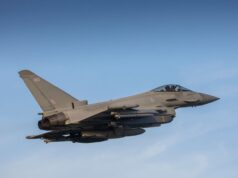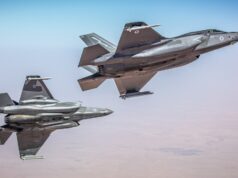The Blue Angels U.S. Navy Flight Demonstration Squadron have taken delivery of a C-130J aircraft formerly belonging to the Royal Air Force.
The aircraft, purchased from the United Kingdom in June 2019, underwent a year-long refresh, which turned the former UK aircraft into the logistics and transport aircraft that will be used by the Blue Angels.
Tactical Airlift Program Office (PMA-207) and the UK MoD co-managed the refurbishment with all efforts performed at Marshall Aerospace and Defence Group (ADG) in Cambridge.
“This has been a great example of cooperation between allies and professionals. Coordination and work to deliver this Blue Angels C-130J highlight a unique program office partnership with UK MoD and Marshall Aerospace. The team has worked through challenges to deliver this high-visibility asset to our fleet, and provide a ‘new’ aircraft to support our Naval Flight Demonstration Squadron for years to come,” said MajGen Greg Masiello, programme executive officer air ASW, assault and special mission programmes.
“We have all been able to witness the transformation of this particular C-130 Hercules transition into a valuable addition to our Blue Angels flying demonstration team. We are pleased to deliver this Super Hercules as the Blue Angels transition to Super Blues. Definitely a job well done by all involved.”
This is the sole C-130J in the Navy’s fleet and while it is almost identical to its sister aircraft, the KC-130J, currently flown by the Marine Corps, it required a collaborative effort between NAVAIR engineering and Lockheed Martin to identify configuration deltas and test requirements.
These efforts were done to meet U.S. and FAA requirements and included a major rework inspection, hardware and software configuration changes, and ground and flight testing.













Why on earth are we selling off valuable air assets which we need?
We have so few.. but let’s sell one back to the yanks!
The Hercules Fleet has room to be wound down,with C17 and A400 Aircraft in the inventory there is no shortage of capacity,The C130’s are basically being kept on the books for Special Forces use.
Hi Paul ……. read somewhere the Germans might not want all their A400’s should we try and pick a couple up… we seem to always have to few then run them into the ground…… ships and planes…
Ian – yes extra A400’s will be the obvious solution should the need arise,as you say some could be had as others cut back their orders.
Well the Germans were buying 50 odd a400s right?
One C5 and 13 C4 versions in inventory I believe?
Or do we have more?
And what happens when the dog poo hits the fan and extra airlift is once again needed…
I thought we were trying to expand our fleets for or own flexibility
And it’s not like the yanks are desperate, unlike us.
Makes no sense to me
We are desperate but not for the assets but instead for cash. Sad reality is that a lot of assets will get silently cut over the next few years.
We should have more, but nope selling them off, the c130J or a new similar needs to be kept for operations where a400s are either too big or can’t do the job.
It’s a curious thing, we joined the FLA program in the 1990’s, to provide an aircraft with much greater capacity than the C130….
The requirement was for a machine with roughly double the load capability and (largely based on British insistence) the same rough field, ground turning etc capability as the C130 … No mean design feat …
Typically, the FLA was rapidly stuck in a European mess of political /design/ mechanical cock ups and the program slowed to a crawl…
The UK required 50 aircraft and had little choice but to go for 25 J model C130’s as a two part solution.
While the J model is a big advance on the old K, it still falls foul of running out of space before it runs out of lifting power and reaches its all up weight capacity, in fact with the J models extra power this is even more an issue….
It wasn’t an issue for the K, because it was primarily envisioned to be operating UK/ Europe 80% of the time and a great deal of gear was simply trucked.
We bought our 25 J’s just as we were forced into a world wide role they aren’t particularly well suited for due to the limited freight load.
The remaining J models are however well suited to the SF task and taking smaller loads when needed.
I would like to see a sizable increase in A400 orders , a total force of 40 to really give us some flexibility to operate.
I would also try and order 4 second hand C17’s from the Yanks to reinforce our heavy lift.
As we transition to lightweight flexible forces, we had best have the proper lift to get them there…..
And they are perfect for SF operations, and could be used for a variety of other ops that a400s can’t do or are too big to do. Surely we can keep a dozen hercs for a decade or more yet.
Cam – That is the Plan.
We have lots of capacity in our strategic air lift fleet, C17, A400 and capacity within the Voyager fleet. We are 2nd only to the Americans when comes to moving equipment and personal around the world.
I have written this before but there are other reasons why the USN were keen on getting an ex RAF C-130J.
Taking an ex-RAF C-130J has a significant advantage for the USN when it comes to transitioning the support crew and load masters from the C-130T. RAF C-130J are unique in having the older Dash 4a cargo handling system in the cargo bay rather than Enhanced Cargo Handling System (ECHS) that all later C-130J were fitted with. USN C-130T are fitted with Dash 4a so switching to an RAF spec C-130J makes plenty of sense in a logistic sense. All the equipment and procedures for loading a C-130T should carry over.
Whilst the vastly superior ECHS was considered the RAF/MOD rejected it thing it would be too complex. Remember the UK was the launch customer for the C-130J which was a Lockheed internal program rather than something requested by the US DOD. This led to some curious issues in respect of the RAF airframes which were built using the worn out jigs used to build the C-130H. This ironically led to problems when they tried to fit the Dash 4a rails only to find they wouldn’t go in without some bending and filing as the datum points were rather off due to the fuselages being built on old jigs.
A further irony as part of the offset work the UK PLc got for being the launch customer for the C-130J is UK industry built a brand new set of production jigs that were dispatched to the US meaning later examples built for the USAF and others didn’t have the same ‘Alignment’ issues that ours faced.
All rather comical really.